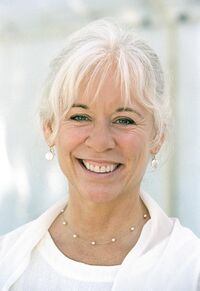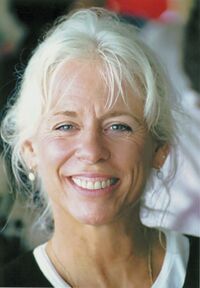Gangaji
Topic: Biography
 From HandWiki - Reading time: 4 min
From HandWiki - Reading time: 4 min
Gangaji (/ˈɡɑːŋɡədʒi/ GAHNG-gə-jee; born Texas, 1942) is an American spiritual teacher and writer. She lives in Ashland, Oregon, with her husband, fellow spiritual teacher Eli Jaxon-Bear.
Early life
Gangaji was born Merle Antoinette Roberson (Toni) in Texas on June 11, 1942, and grew up in Mississippi. After graduating from the University of Mississippi she and her young family moved to San Francisco . After a divorce[1] she sought to change her life via political activism and spiritual practice. She took Buddhist Bodhisattva vows, practiced Zen and Vipassana meditation, and began a career as an acupuncturist in the San Francisco Bay area. Unfulfilled by her seemingly successful life, in 1989 she and Jaxon-Bear moved to Hawaii.[2]
Papaji
At this time she met Andrew Cohen, a spiritual teacher and student of Sri H.W.L. Poonja, also known as Papaji. Impressed by Cohen’s "enormous confidence", she returned to California to sit with him for two months.[3] In the meantime, Jaxon-Bear, who had become her second husband, met Papaji in India. Struck by the letters she received from Jaxon-Bear, Gangaji herself traveled to Lucknow, India to meet Papaji in 1990. In her autobiography Just Like You she wrote, "The extraordinary event in this life was that I met Papaji. Until then I looked everywhere for the transcendental or the extraordinary, but after meeting Papaji I began to find the extraordinary in every moment."[2] Papaji gave her the name Gangaji, and asked her to share what she had directly realized with others.[1]
Teaching
Gangaji currently writes and tours as a teacher. She holds that the truth of who you are is already free and at peace, which can be realized simply by ending one’s search.
I invite people to just stop and be still. And in that you discover who you are, because once you discover who you are, you can stop fragmenting into pieces. I know that in any one day there are moments where there is nothing going on, but we link up what is happening from thought to thought without any space. We overlook the spaciousness that it is all happening in.[4]
Gangaji uses a personal form of inquiry to aid in the realization of 'direct experience':
I use inquiry as a way of getting the mind to turn inward to the silence. It could be the question, "Who am I?" Or it could be "What am I avoiding in this moment?" Or, "Where is silence?" "What is needed in this moment, right in this very moment, what is needed for true peace?" "What is needed if this was my last moment on earth?" Rather than sending the mind outward to gather information or experiences, it is really sending the mind inward to question our basic assumption of who we think we are.[5]
In facing strong emotions such as fear and anger, or in dealing with traumas which keep people locked in personal misery and unable to experience freedom, Gangaji teaches "direct experience," or meeting whatever emotion is present. For example, she says, "Fear is about survival. When you drop under that and experience the fear without trying to change it, just letting it be, then it becomes still. When you open your heart to fear, rather than trying to fight it or deny it or even overcome it, then you find it is just energy."[6]
Gangaji Foundation
Since 1993 Gangaji’s work has been supported by The Gangaji Foundation, a non-profit headquartered in Ashland, Oregon. Its mission statement states: "The Gangaji Foundation serves the truth of universal consciousness, and the potential for the individual and collective recognition of peace inherent in the core of all being. It is the purpose of the Gangaji Foundation to forthrightly and respectfully present the teaching and transmission of Gangaji.
The Gangaji Foundation produces events, publishes books and videos, hosts a website and runs several outreach programs including a prison program.
Personal life
In October 2005, Gangaji's husband, Eli Jaxon-Bear, admitted to Gangaji that he had had a three-year affair with an adult female student and executive director of his organization, the Leela Foundation.[7] After a brief separation, Gangaji and her husband reconciled their marriage in December 2005. At the student’s request, the information about the affair was not made public at that time.[8] In January 2006, Gangaji and her husband merged their foundations, continuing to teach together and separately.
In October 2006, Jaxon-Bear disclosed his extramarital relationship to the Gangaji Foundation's board of directors and staff. For a time Jaxon-Bear stopped teaching. Both he and the Gangaji Foundation held open meetings with the stated purpose to heal whatever wounds may have been experienced in their spiritual community.[7] In addition Gangaji, and eventually she and her husband, held retreats on the subjects of disillusionment, betrayal, and relationship.
Bibliography
Books
- You are That!. Satsang Press. 1995. ISBN 0-9632194-3-X.
- Freedom and Resolve. Gangaji Foundation. 1999. ISBN 1-887984-01-1.
- (with Roslyn Moore) Just Like You. DO Publishing. 2003. ISBN 0-9646999-2-3.
- The Diamond in Your Pocket: Discovering Your True Radiance. Sounds True. 2007. ISBN 1-59179-272-X.
- Hidden Treasure: Uncovering the Truth in Your Life Story. Penguin Publishing Group. 2011. ISBN 1-58542-887-6.
- Freedom and Resolve, Finding Your True Home in the Universe. Hampton Roads Publishing. 2014. ISBN 1571747214.
Chapters
- Robinson, Rita, ed (2007). Ordinary Women, Extraordinary Wisdom: The Feminine Face of Awakening. O Books. pp. 209–231. ISBN 978-1-84694-068-2.
- Shapiro, Ed; Shapiro, Deb, eds (2009). Be the Change: How Meditation Can Transform You and the World. Sterling Ethos. ISBN 1-4027-6001-9.
Notes
- ↑ 1.0 1.1 Gangaji. "The End of All Excuses". http://www.gangaji.org/index.php?modules=content&op=all_excuses.
- ↑ 2.0 2.1 Gangaji; Moore, Roslyn (2003). Just Like You, An Autobiography. Do Publishing. p. 137. ISBN 0-9646999-2-3.
- ↑ Hammond, Holly (May–Jun 1994). "A Conversation with Gangaji". Yoga Journal: 41.
- ↑ Shapiro & Shapiro (2009), p. 268.
- ↑ Shapiro & Shapiro (2009), p. 285.
- ↑ Shapiro & Shapiro (2009), p. 94.
- ↑ 7.0 7.1 "Spiritual leaders' split leads to consolidation of groups". Ashland Daily Tidings. October 14, 2006. http://www.dailytidings.com/2006/1014/stories/1014_gangaji.php.
- ↑ Denempont, Barbara (October 10, 2006). "Letter from Boards of Leela & Gangaji Foundations". The Gangaji Foundation. https://web.archive.org/web/20090223180751/http://gangaji.tribe.net/thread/e7b6401a-94e3-4f1c-89f2-9a5b18512aa0.
References
- Shapiro, Ed; Shapiro, Deb (2009). Be the Change: How Meditation Can Transform You and the World. Sterling Ethos. ISBN 978-1-4027-6001-3.
Further reading
- Downing, Jerry N. (2000). Between Conviction and Uncertainty. ISBN 0-7914-4627-1.
External links
 |
 KSF
KSF

